Updated January 23, 2008:
Don't you guys (my readers) realize why you even bother to come to this obscure blog? The reason you come, whether you realize it or not, is because you find information, photos, and photo essays here that are difficult, if not impossible to find elsewhere on the web.
Don't forget the contextual articles that group together many different obscure Internet pieces with analysis, commenting and photo essays. Do you realize how long it would take you to trawl around the Net gathering up all this stuff on your own? All this we do for you, dear readers, and we don't even charge admission!
As another example of the great blog value you get here on Robert Lindsay, we offer you some excellent maps of the region of Iraq where Abu Musab Al Zarqawi, notorious leader of Iraqi Al Qaeda, was killed by two 500-pound bombs dropped by a US F-16 at 6:15 PM on Wednesday, June 7, Baghdad time.
Apparently Jordanian intelligence was involved in tracking him down through both analysis of the formless terrain on a recent videotape he arrogantly released and betrayal by an informer from his own organization, who was a Jordanian intelligence asset.
The mainstream media has told us that he was killed either in the city of Baqubah or the city of Hibhib, 10 1/2 miles west of Baqubah (background on Hibhib here).
There have been a series of horrible crimes committed by terrorists in and around Hibhib recently, which suggested the presence of a nasty terrorist cell in the area.
First there were a series of 17 severed heads of Shia civilians found in fruit boxes around the city. Then a bus was stopped just north of Hibhib, and 19 people, mostly high school students, were ordered out of the bus and all of the Shia, including 12 Shia high school and college students traveling to Baqubah for exams, were murdered.
The suggestion is that locals were disgusted by this brutality and may have helped turn Zarqawi in. Both cities, Hibhib and Baqubah, are in red-hot Diyala Province, where the Iraqi Civil War is currently raging.
He was killed at a meeting with six colleagues, at least according to the US Central Command statement, 8 kilometers (5 miles) north of Baqubah. The US Centcom statement appears to be incorrect. Hibhib is west-northwest, at best, of Baqubah, not due north at all. On my map it is 17 km W/NW of Baqubah. On another map it is 8 km W/NW of Baqubah. I believe 17 km away is correct, based on this BBC map here.
The five colleagues, including a woman thought to be his wife, Zarqawi's spiritual advisor, a young boy thought to be his son, and three other persons who were not identified (the age, sex, and identity of those killed with Zarqawi seem to constantly change with various news reports on different days) were also reportedly killed in the steel-reinforced safehouse surrounded by palm trees.
Subsequent news reports say reporters went to the city of Hibhib to see where he was blasted away. That implies that Zarqawi was in fact killed in Hibhib.
What is interesting is that as far back as January 2005, Iraqi intelligence reports connected Zarqawi to Hibhib.
Those reports said that Zarqawi was hiding in between the Dora District of Baghdad and Baqubah and Hibhib in Diyala Province, that he was keeping a contingent force in Khalis and Hibhib to ambush convoys traveling between Baghdad and Kirkuk, and that he was spending time in the town of Ghalabiyah, near Khalis.
So Zarqawi, instead of showing up in Hibhib recently, may have been there off and on for 1 1/2 years.
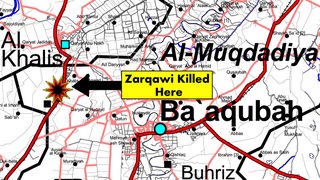 This shows where Zarqawi was killed, 1 1/4 miles north of Hibhib (the black square to the southwest of the explosion mark), which is about 10 miles west/northwest of Baqubah. The location description given by Centcom - 8 km north of Baqubah - is inaccurate. That location is about where the "Zarqawi Killed Here" banner is. Copyright Oakhurst Technology 2006.
This shows where Zarqawi was killed, 1 1/4 miles north of Hibhib (the black square to the southwest of the explosion mark), which is about 10 miles west/northwest of Baqubah. The location description given by Centcom - 8 km north of Baqubah - is inaccurate. That location is about where the "Zarqawi Killed Here" banner is. Copyright Oakhurst Technology 2006.Zarqawi's hideout was about 1 1/4 mile northeast of the center of Hibhib. The hideout was surrounded by large US bases. For instance, the hideout is only six miles Southeast (and on the other side of the Tigris) from the largest US base in Iraq, LSA Anaconda and is also only about 3-4 miles west of the brigade-sized base at Baqubah called Camp Freedom I.
An excellent map of Zarqawi's hideout can be found by going to Google Earth's location here. The apparent coordinates are 33.48' 03.19"N 44.30 48.09E.
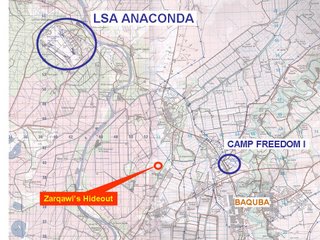 An excellent, highly detailed map of the part of Diyala Province where Zarqawi was hiding. Click on the map to view it in greater detail. As you can see, Hibhib is not really north of Baqubah at all, but is actually West/Northwest of the city. Copyright Oakhurst Technology and distwalker 2006.
An excellent, highly detailed map of the part of Diyala Province where Zarqawi was hiding. Click on the map to view it in greater detail. As you can see, Hibhib is not really north of Baqubah at all, but is actually West/Northwest of the city. Copyright Oakhurst Technology and distwalker 2006.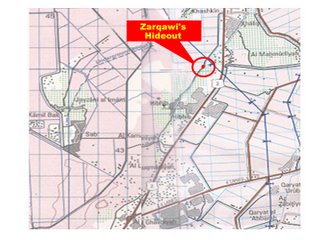 This is a zoom shot of the same superb map showing where Zarqawi was killed. As you can see, the location is just northwest of Hibhib - 1 1/4 miles northwest of Hibhib to be precise. Compare to the two photo shots below. Copyright Oakhurst Technology and distwalker 2006.
This is a zoom shot of the same superb map showing where Zarqawi was killed. As you can see, the location is just northwest of Hibhib - 1 1/4 miles northwest of Hibhib to be precise. Compare to the two photo shots below. Copyright Oakhurst Technology and distwalker 2006.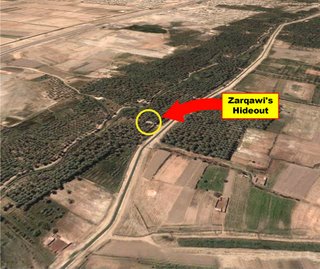
This excellent map shows a detailed view of the precise location of Zarqawi's hideout. It can be found at the Google Earth url linked above. The coordinates are also listed above. On the map, north is at the bottom and south is at the top. The town of Hibhib can be seen in the far right corner of the map. This map can also be found at this url.
It comes from a former US Army paratrooper and infantryman whose son is an Army Ranger in the 75th Regiment on his third tour in Iraq. Compare this map to the superb New York Times photo map here and the map below to get a better perspective. Copyright Oakhurst Technology and distwalker 2006.
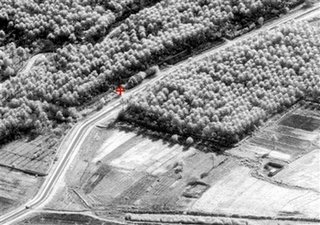 An excellent photo of the exact location of the hideout, taken from an Associated Press copy of a US Department of Defense photograph linked on Yahoo News photographs. Compare it to the Google Earth coordinate map and the New York Times photo map, both linked above.
An excellent photo of the exact location of the hideout, taken from an Associated Press copy of a US Department of Defense photograph linked on Yahoo News photographs. Compare it to the Google Earth coordinate map and the New York Times photo map, both linked above.Many other articles are commenting on Zarqawi's life and death, so there is no need to re-plow those fields here (this Atlantic piece is especially good). An excellent roundup of reports on Zarqawi and related reports on the Iraqi insurgency peripheral to Zarqawi can be found here, on the essential Counterterrorism Blog .
Iraqi Al Qaeda has already appointed a successor. Abdallah Bin Rashid al Baghdadi, head of the Mujahedin Shura Council in Iraq, has been appointed head of Iraqi Al Qaeda. This ought to put to rest confusing statements by my friends that the Shura Council is actually nationalist-dominated.
Wariya Arbili, according to Debka, is now the top Al Qaeda operative in Iraq. Arbili is head of Ansar Al Sunna, an Islamofacsist terrorist group with roots in the (officially dissolved, but actually just subsumed into other groups) Islamofascist terrorist group Ansar Al Islam. I believe that AAS has formalized an alliance with Iraqi Al Qaeda in recent months, but they were always ideologically close.
Debka says that AAS controls significant swaths of Iraq - particularly parts of Kurdistan. They also have a presence in Kirkuk, Mosul, Tal Afar and parts of the Sunni triangle. They are definitely active around Hit, Ramadi and Fallujah in Anbar Province and down around Madaen, Salman Pak, Yusufiyah, Latifiyah and other parts of the Triangle of Death south of Baghdad in Babil Province.
I agree that AAS probably has a large presence in Tel Afar, but my information is that a while back it was Ansar Al Islam that had a huge presence there. Anyway, AAI and AAS are pretty much the same thing. AAS is a superset of AAI.
On the day of the Zarqawi hit, US TV news turned into Z News, or Zarqawi News - All Zarqawi, All The Time - complete with the usual triumphalist BS we have come to expect from this Administration and its de facto US-government controlled TV news organs. This is a turning point, we are told, we are winning the war, the terr'rists are on the run. The rightwing Internet blog echo chamber was also working overdrive.
I am as happy as anyone to see Zarqawi dead. After all, I am a sane secular Leftist who is self-aware enough to realize that these Islamofascists are Enemy Number One of my comrades and me.
I supported the relentless war the Algerian state waged against Islamofascist barbarians in Algeria, in which they killed maybe 10,000's of Salafist primitives (though not the abuses that that entailed).
Much as I disliked the Afghan Communist regime, I think they did a superb job of slaughtering armed Islamic fundamentalists, always a noble and commendable operation. Saddam Hussein also killed all sorts of dangerous Sunni fundamentalist throwbacks, an achievement for which he ought to be commended.
Egypt killed 9,000 of these armed barbarians in the past decade and temporarily defeated the Islamic Jihad insurgency that was machine-gunning tourists at pyramid sites like Luxor.
As far as jihadi-Salafists like Zarqawi go, in my opinion you cannot kill enough of them. Most Salafist women, most Salafist older males and all Salafist minors should be spared, but Salafist-jihadi males aged 18-50 are simply dangerous, whether armed or not.
They have a poisonous ideology that should be banned outright, and most of them can turn dangerous any time. In many cases they need to be thrown out Western countries if they are not citizens, and even have their citizenship revoked, if they are citizens. If that's un-Constitutional, then amend the Constitution.
All Muslim immigrants to Western countries should be questioned intensively, and all those espousing Sunni Salafist ideology should be banned from entering.
That said, the question begs: What will Zarqawi's death do the three major wars currently raging in Iraq - the Shia guerrilla war against Coalition troops, the communal civil war and the Sunni guerrilla war against US forces? I do not think his death will benefit any of these conflicts.
In the same way that after Saddam's capture, guerrilla operations surged for a few months, I think we may be in for a similar rerun here.
Keep in mind that many of the Sunni tribes and even a lot of the Sunni nationalist guerrilla groups have histories of conflicts with Iraqi Al Qaeda. This conflict has periodically broken out into open warfare. No doubt some Iraq's Sunni nationalist fighters are cheering the death of this maggot. No doubt his removal will give their groups a shot in the arm.
Sure, Iraqi Al Qaeda may be down for the punch for a while, but maybe they aren't. Anyway, the notion that the Sunni insurgency is in any way dependent on Iraqi Al Qaeda is patent nonsense. If anything, it was a drag on the movement and unnecessarily vicious and divisive.
Furthermore, if Iraqi Al Qaeda's operations are reduced, we may not see much difference. Many of the Iraqi Sunni nationalist groups have now become, as Zarqawi's plot had anticipated, just as vicious, murderous and terroristic towards the Shia as Iraqi Al Qaeda was.
The Shia resistance has been caught up in the sectarian struggle with the Sunnis, which has diverted them from attacks on Coalition forces.
Furthermore, all Iraqi Shia guerrilla groups were tainted due to the association of Iraqi Al Qaeda with the insurgency itself, since the Shia in general, including the Lebanese Hezbollah, hate Zarqawi with a passion. With IAQ temporarily wounded, the Shia may feel freer to attack US forces.
For all of these reasons, I don't expect this killing to do much. Instead, I am afraid it may even give the guerrilla movement a shot in the arm. Time will tell.
Update: I have responded to my colleague Brian's (who is currently in Jordan doing citizen journalism and blogging with Iraqi colleagues) critique on his blog of some of the points I made in this post in the comments section at the end of this post.
Note: Readers should carefully read the Commenting Rules before commenting to avoid having their comments edited or deleted and to avoid being banned from the site.
No comments:
Post a Comment